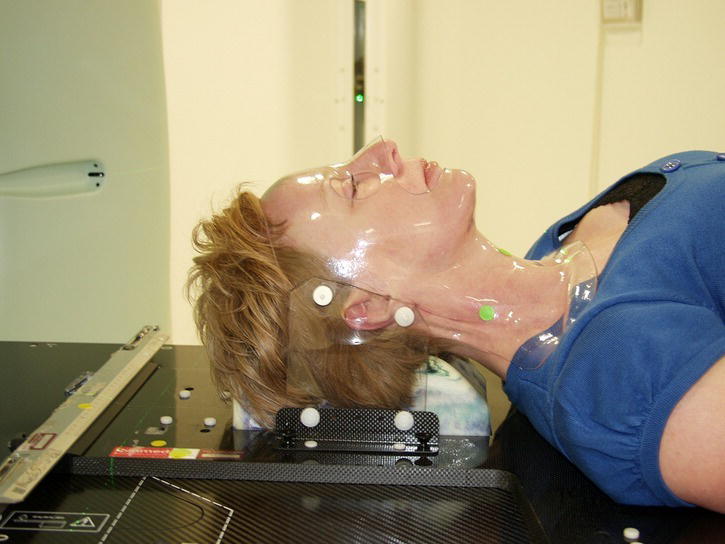Chapter 5 Alexandra Gilbert, Emma Dugdale and Robin Prestwich St James’ Institute of Oncology, UK Radiotherapy itself is painless during delivery. Radiotherapy is a localised treatment and therefore other than treatment-related fatigue, side effects are related to the anatomical area of the body that is receiving treatment. For example treatment to the thorax will not cause lower GI symptoms such as diarrhoea. There are a number of clinician reported acute and late toxicity grading systems in clinical use, including the Common Terminology Criteria for Adverse Events (CTCAE version 4). There are three types of toxicity: Table 5.1 Side effects and management of radiotherapy to the brain. Table key for all side effects: a = rare, b = uncommon, c = frequent, N/A = not applicable (frequency of side effects for each site adapted from Ahmad SS, Duke S, Jena R, Williams MV, Burnet NG. Advances in radiotherapy. British Medical Journal. 2012. 345: e7765). Figure 5.1 Example of a perspex mask used in head and neck radiotherapy. Image courtesy of Medical Illustrations, St James’ Institute of Oncology. To see a colour version of this figure, see Plate 5.1. Table 5.2 Side effects of head and neck radiotherapy. Table key for all side effects: a = rare, b = uncommon, c = frequent, N/A = not applicable (frequency of side effects for each site Ahmad SS, Duke S, Jena R, Williams MV, Burnet NG. Advances in radiotherapy. British Medical Journal. 2012. 345: e7765). Table 5.3 CTCAE (V4.03) grading of mucositis. From the website of the National Cancer Institute (http://www.cancer.gov). Chapter 3, sections on dental disorders, mucositis
Radiotherapy side effects andtheir management
Overview of radiotherapy toxicity
Risk of second malignancies
Causes of toxicity
The effect of radiotherapy schedules on toxicity
Overview of radical radiotherapy treatment and side effect management by anatomical treatment site
Brain
Side effects
Early
Late
Notes
Alopecia
c
a
Dependent on area in radiotherapy field. Patchy re-growth possible.
Cognitive decline
N/A
b
Dose dependent. Non-reversible.
Fatigue
c
a
Common during and in the first few weeks post treatment.
Headache
b
N/A
Usually responds to starting/increasing steroids.
Hearing loss
a
N/A
Dependent on area in radiotherapy field.
Loss of taste
a
N/A
Dependent on area in radiotherapy field.
Nausea and vomiting
b
N/A
Consider steroids in addition to anti-emetics.
Pituitary dysfunction
N/A
c
May require referral to an endocrinologist.
Scalp erythema
b
N/A
See skin toxicities section.
Somonolence syndrome
c
N/A
Occurs 4–6 weeks after radiotherapy has finished. Self-limiting, no specific treatment.
Indications and example radical regimes
Head and neck

Indications and example radical regimes
Head and neck radiotherapy side effects
Side effects
Early
Late
Notes
Alopecia
b
a
Dependent on area in radiotherapy field.
Aspiration risk
b
b
See management of early head and neck toxicity section.
Cataracts
N/A
a
Dependent on area in radiotherapy field.
Dental problems
N/A
a
All patients are seen by a dentist prior to start of radiotherapy treatment to extract any diseased teeth, with the aim of preventing osteonecrosis. Dry mouth post radiotherapy increases the risk of dental decay.
Dry mouth (xerostomia)
b
c
See management of late head and neck toxicity section.
Dysgeusia (altered taste/smell)
c
c
Taste generally improves in the months post radiotherapy.
Dysphagia
c
b
May require enteral feeding and analgesia. May develop oesophageal stricture in long term.
Fatigue
c
a
Common during and in the first few weeks post treatment.
Hoarseness
b
b
Speech generally improves within a few months and with SALT support.
Hearing loss
a
a
Related to cisplatin use and dependent on area in radiotherapy field.
Lymphoedema (under the chin)
N/A
a
Mucositis (oral)
c
N/A
See management of early head and neck toxicity section.
Odynophagia
c
N/A
See upper GI side effects section.
Osteonecrosis of the jaw
N/A
b
Teeth extractions and high doses of radiotherapy to the mandible increase risk.
Pituitary dysfunction
N/A
a
Dependent on area in radiotherapy field.
Skin reaction (acute)
c
N/A
See skin toxicities section.
Skin reaction (chronic)
N/A
b
See skin toxicities section.
Trismus (jaw stiffness)
N/A
a
Risk depends of position of radiotherapy. If this is a risk patients will be given jaw opening exercises.
Throat secretions
c
N/A
See management of early head and neck toxicity section.
Thyroid gland dysfunction
N/A
a
Dependent on area in radiotherapy field.
Grade
Criteria
1
Asymptomatic or mild symptoms; intervention not indicated.
2
Moderate pain; not interfering with oral intake; modified diet indicated.
3
Severe pain; interfering with oral intake.
4
Life-threatening consequences; urgent intervention indicated.
5
Death.
Management of early head and neck toxicity
Management of late head and neck toxicity
Other relevant sections of this book
Breast
Stay updated, free articles. Join our Telegram channel

Full access? Get Clinical Tree





